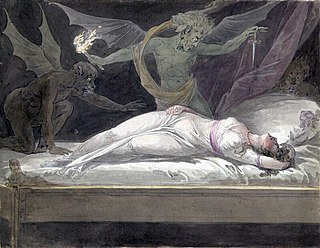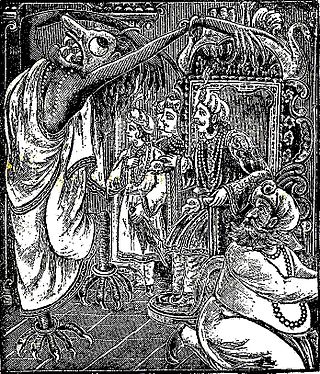
Sleep paralysis is a state, during waking up or falling asleep, in which a person is conscious but in a complete state of full-body paralysis. During an episode, the person may hallucinate, which often results in fear. Episodes generally last no more than a few minutes. It can recur multiple times or occur as a single episode.

The bogeyman is a mythical creature used by adults to frighten children into good behaviour. Bogeymen have no specific appearances and conceptions vary drastically by household and culture, but they are most commonly depicted as masculine or androgynous monsters that punish children for misbehaviour. The bogeyman, and conceptually similar monsters can be found in many cultures around the world. Bogeymen may target a specific act or general misbehaviour, depending on the purpose of invoking the figure, often on the basis of a warning from an authority figure to a child. The term is sometimes used as a non-specific personification of, or metonym for, terror, and sometimes the Devil.

Kikimora is a legendary creature, a female house spirit in Slavic mythology. Her role in the house is usually juxtaposed with that of the domovoy. The kikimora can either be a "bad" or a "good" spirit, which will depend on the behavior of the homeowner. When the kikimora inhabits a house, she lives behind the stove or in the cellar, and usually produces noises similar to those made by mice in order to obtain food.
In Slavic mythology, notsnitsa, often referred in plural, is a nightmare spirit or demon that torments people and especially children at night. Other names for notsnitsa in East Slavic languages include kriksy, plaksy, plachky, plaksivicy, kriksy-varaksy, kriksy-plaksy, night hag, night maiden.

An incubus is a demon in male form in folklore that seeks to have sexual intercourse with sleeping women; the corresponding spirit in female form is called a succubus. Parallels exist in many cultures.
A shadow person is the perception of shadow as a living species, humanoid figure, sometimes interpreted as the presence of a spirit or other entity by believers in the paranormal or supernatural.

A mare is a malicious entity in Germanic and Slavic folklore that walks on people's chests while they sleep, bringing on nightmares.
Popobawa, also Popo Bawa, is the name of an evil spirit or shetani, which is believed by residents of Zanzibar to have first appeared on the Tanzanian island of Pemba. In 1995, it was the focus of a major outbreak of mass hysteria or panic which spread from Pemba to Unguja, the main island of the Zanzibar Archipelago, and across to Dar es Salaam and other urban centres on the East African coast.

The Nightmare is a 1781 oil painting by Swiss artist Henry Fuseli. It shows a woman in deep sleep with her arms thrown below her, and with a demonic and ape-like incubus crouched on her chest. The painting's dreamlike and haunting erotic evocation of infatuation and obsession was a huge popular success.

An Alp is a supernatural being in German folklore.

Brazilian mythology is the subset of Brazilian folklore with cultural elements of diverse origin found in Brazil, comprising folk tales, traditions, characters and beliefs regarding places, people, and entities. The category was originally restricted to indigenous elements, but has been extended to include:
A soucouyant, among other names, is a kind of shape-shifting, blood-sucking hag present in Caribbean folklore.
The Batibat is a vengeful demon found in Ilocano folklore. In Tagalog folklore, the creature is called Bangungot. The batibat takes the form of an ancient, grotesquely obese, tree-dwelling female spirit. They usually come in contact with humans when the trees in which they reside are felled and are made homeless, especially when their tree is made into a support post for a house. This causes them to migrate and inhabit what is left of their tree. The batibat forbids humans from sleeping near its post. When a person does sleep near it, the batibat transforms into its true form and attacks the person by suffocating their victim and invading their dream space, causing sleep paralysis and waking nightmares. This condition lends itself to the Ilocano word for nightmare, "batíbat". To ward off the batibat, one should bite one's thumb or wiggle one's toes. In this way, the person will awaken from the nightmare induced by the batibat.
Mythic humanoids are legendary, folkloric, or mythological creatures that are part human, or that resemble humans through appearance or character. Each culture has different mythical creatures that come from many different origins, and many of these creatures are humanoids. They are often able to talk and in many stories they guide the hero on their journey.

Ghosts are an important and integral part of the folklore of the socio-cultural fabric of the geographical and ethno-linguistic region of Bengal which presently consists of Bangladesh and the Indian states of West Bengal and Tripura. Bengali folktales and Bengali cultural identity are intertwined in such a way that ghosts depicted reflect the culture it sets in. Fairy tales, both old and new, often use the concept of ghosts. References to ghosts are often found in modern-day Bengali literature, cinema, radio and television media. There are also alleged haunted sites in the region. The common word for ghosts in Bengali is bhoot or bhut. This word has an alternative meaning: 'past' in Bengali. Also, the word Pret is used in Bengali to mean ghost. In Bengal, ghosts are believed to be the unsatisfied spirits of human beings who cannot find peace after death or the souls of people who died in unnatural or abnormal circumstances like murders, suicides or accidents. Non-human animals can also turn into ghosts after their death. But they are often associated with good luck and wealth in Bangladesh.

A hag is a wizened old woman, or a kind of fairy or goddess having the appearance of such a woman, often found in folklore and children's tales such as "Hansel and Gretel". Hags are often seen as malevolent, but may also be one of the chosen forms of shapeshifting deities, such as The Morrígan or Badb, who are seen as neither wholly benevolent nor malevolent.

Sudden arrhythmic death syndrome (SADS) is a sudden unexpected death of adolescents and adults caused by a cardiac arrest. However, the exact cause of the cardiac arrest, and thus the exact cause of death, is unknown. These deaths occur mainly during sleep or at rest. One type of conduction defect known as Brugada syndrome can be responsible.

Spectrophilia, also known as Phasmophilia, is sexual attraction to either ghosts or sexual arousal from images in mirrors, as well as the alleged phenomenon of sexual encounters between ghosts and humans.
A Basty or Bastı is an evil spirit or goblin in Turkic mythology which rides on people's chests while they sleep, bringing on bad dreams.










